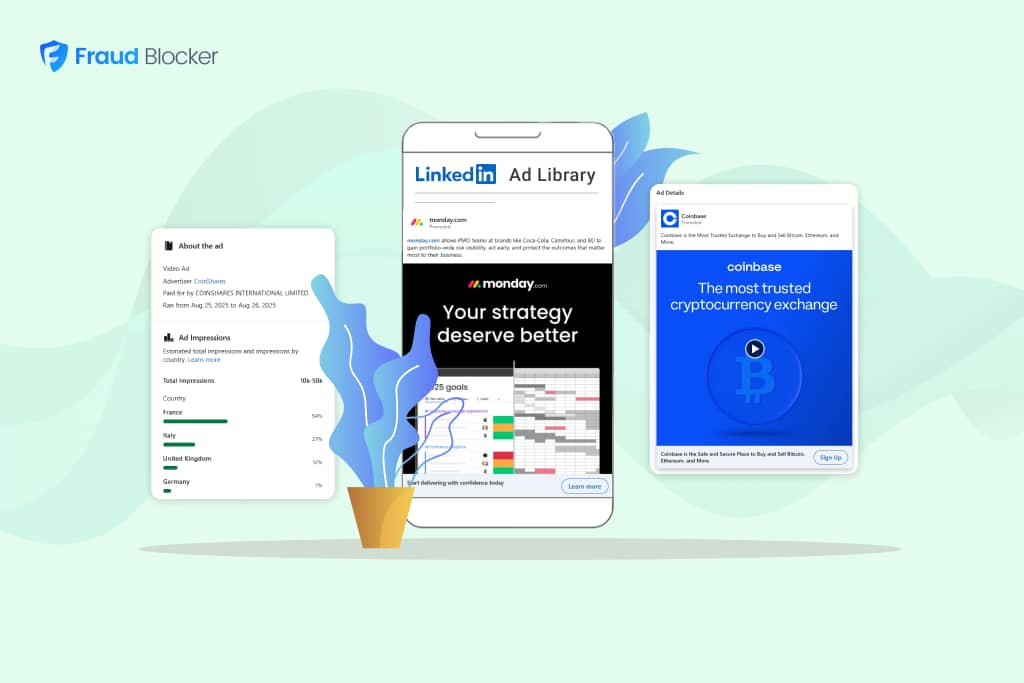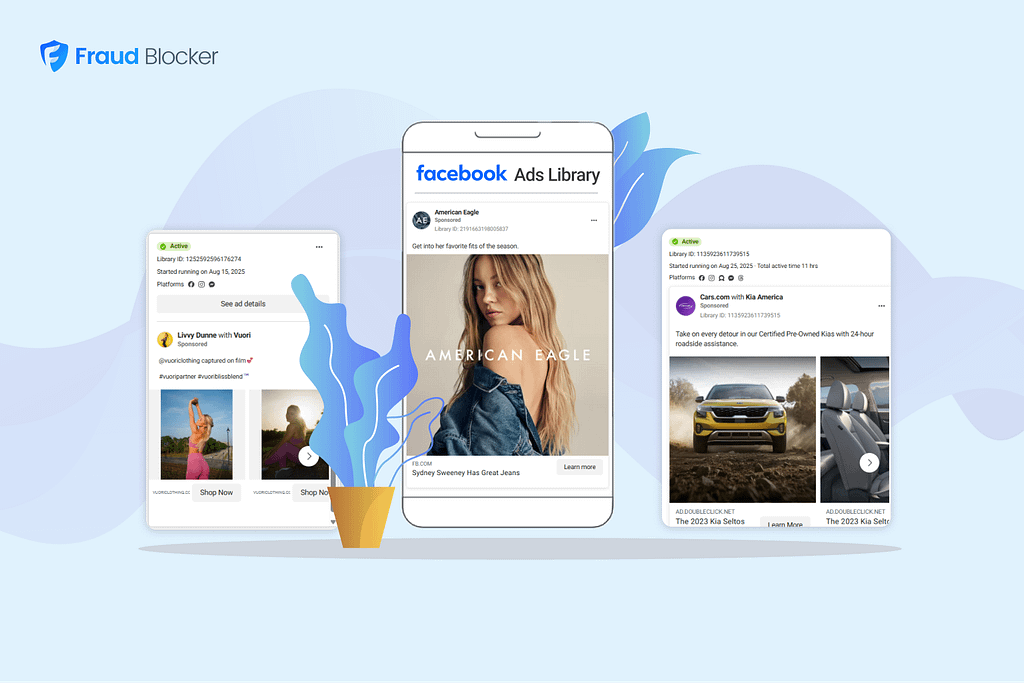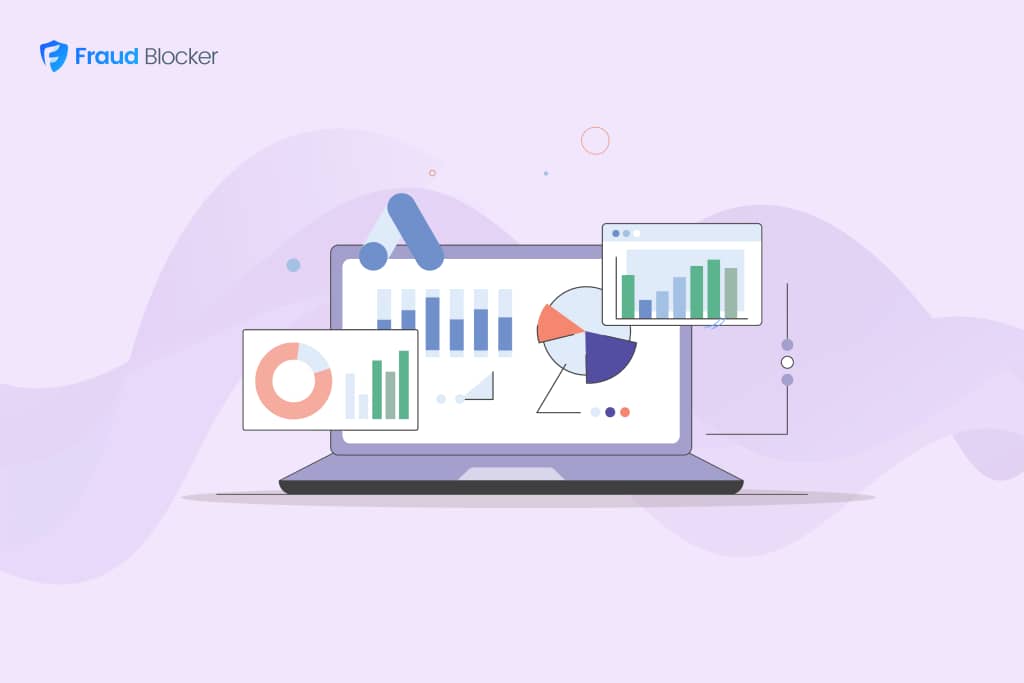
New report:
Invalid Click Rate Benchmarks


Click fraud is costing advertisers billions in loses. Learn more here.

Click fraud is costing advertisers billions in loses. Learn more here.
LinkedIn is where B2B brands go to win attention from decision-makers. But ads are expensive (average CPC of $3.94), and figuring out what resonates with your audience can burn through your budget fast.
That’s why the LinkedIn Ad Library is such a powerful resource. It gives you direct insight into what other businesses are doing, whether that’s your direct competitors, or some of the biggest brands in the world. You can see their ad copy, creatives, CTAs, and even the landing pages they’re sending traffic to. In some regions, you’ll also get a glimpse of targeting and ad impression data.
The big advantage here is clarity. If a competitor is running hundreds of ads or using the same angle over and over, it’s a clear sign that strategy is working. Instead of testing blind, you can study those ads, spot patterns, and adapt the ideas to your own ad campaigns.
In this guide, we’ll walk through what the LinkedIn Ad Library is, how to use it, and practical examples for extracting insights from competitor campaigns.
The LinkedIn Ad Library is a free, searchable database of every ad currently running on LinkedIn. You don’t need an ad or LinkedIn account to access it.
Here’s what it looks like:
Inside, you can look up ads by company name, keyword, country, or date range. Each search shows you the full ad preview, including the copy, creative, call-to-action, and a direct link to the landing page. For ads running in the European Union, LinkedIn also shows additional details like impression counts and targeting breakdowns.
For marketers, that transparency is gold. You can see exactly how competitors are pitching their products, which formats they rely on, and how they’re structuring funnels from ad to landing page.
Getting into the LinkedIn Ad Library is simple:
One of the most powerful ways to use LinkedIn Ad Library is to see exactly what your competitors are doing. You can look at their ad type, ad copy, creative, and CTAs to understand how they position themselves.
Are they leaning on ROI? Efficiency? Thought leadership? These choices reveal the tone they think resonates with their audience. Additionally, do they favor a similar CTA across their ads? Or does the approach change?
Another useful indicator is volume. If a competitor is running dozens or even hundreds of LinkedIn ads, they’ve clearly found the platform effective. That’s a signal there may be untapped opportunity for your business as well.
One of the most valuable filters in LinkedIn Ad Library is the ability to search by country. This lets you compare how global companies tweak their messaging, creative, and offers depending on the market.
For example, a U.S. campaign might highlight ROI and efficiency, while the same brand could run localized ads in Europe that emphasize compliance or promote a different part of their offering. Sometimes you’ll even find competitors testing completely different hooks in international markets before bringing them back home.
Studying these differences gives you a playbook for shaping your own international campaigns. You can learn which messages/creatives stay consistent across borders, which ones change, and spot fresh angles that haven’t yet saturated your local audience.
Most LinkedIn Ads lead to a landing page. That’s where you see how a brand delivers on the promise it made in the ad.
This is a goldmine for marketers. You can study how competitors align their ad creative and copy with the page headline, what forms or CTAs they use, and how much friction they put in the way of a conversion. For example, some brands push straight to a demo request, while others ease visitors in with a whitepaper or report.
Look closely at the design choices too. Are they using short, benefit-driven copy or long product explanations? Do they gate content behind forms, or let you access it instantly? Each approach signals a different funnel strategy, and knowing this helps you refine your own.
The best practice is always consistency between ad and landing page. But by analyzing what competitors are doing differently, you can find gaps to exploit and opportunities to outperform.
LinkedIn offers a wide mix of ad formats: single image ads, video ads, carousels, document ads, direct messages, and more. By browsing the Ad Library, you can see which ones your competitors lean on most.
If you notice that a majority of ads in your niche are video-based, that’s a clue that video is performing well with your shared audience. On the other hand, if competitors are heavily invested in document ads or carousels, it may be worth testing those formats to see if they drive stronger engagement for you too.
The key is to look for patterns. Consistent use of certain formats usually means those ads are delivering results. And if you search ads and spot a an ad type that no one in your industry seems to use, it could be an opportunity to stand out with a different creative approach.
LinkedIn Ad Library isn’t just for tracking the brands already on your radar; it can also help you find new competition you didn’t know you had. Simply search with industry keywords.
This is especially useful in fast-moving industries where new players enter the market regularly. For example, a search for “cybersecurity” or “AI software” may bring up startups you’ve never heard of, but who are already putting serious money into LinkedIn ads.
This type of new competitor analysis helps you understand the landscape before they scale further. It also gives you a chance to study their positioning and creative angles, and decide how you’ll differentiate your brand.
LinkedIn Ad Library doesn’t just show standard sponsored posts. You can also see examples of Ads that personalize outreach to users.
A great example are Message Ads that pull in profile data like a person’s first name or company name, making the ad feel more direct. These give you ideas for how to use personalization. By analyzing how top advertisers structure subject lines, opening hooks, and calls-to-action, you can learn what grabs attention and drives clicks in this more private channel.
Here are some standard customizations to explore:
If you’re looking at ads served in the European Union, LinkedIn Ad Library gives you more detail than usual. To comply with regulations, LinkedIn shows impression counts and targeting breakdowns by country.
This extra layer of visibility is incredibly useful. You can see how competitors split their spend between regions, which markets they prioritize, and how broadly or narrowly they target. Even if you don’t run campaigns in the EU, these insights give you a window into how global advertisers allocate their budgets.
Not every campaign in the LinkedIn Ad Library is designed for scale. Some advertisers run highly targeted campaigns with very low impression counts: ads crafted for just a handful of accounts or executives.
For example, Semrush has been seen running creatives tailored to specific companies like Duolingo and Windstream, likely aiming ads directly at senior leaders inside those organizations. The reach is small, but the precision makes it clear these campaigns are built for Account-Based Marketing.
Studying these out-of-pocket strategies helps you uncover unique secrets about how other companies approach marketing. Besides the top-level ABM approach, you can also see how they vary copy and creatives for accounts of different sizes.
Like the Facebook Ad Library, LinkedIn’s Ad Library is an excellent tool for competitive research. You can study your rivals’ strategies, uncover new players, and pull inspiration for ads, CTAs, and landing pages. But all of that work only pays off if the traffic you drive is real.
PPC click fraud is a growing issue and low-quality traffic can distort your ad data. Bots, fake accounts, and even competitors can waste your budget by driving invalid clicks, leaving you with campaigns that look like they’re underperforming; when in reality, it’s the traffic that’s flawed. This means the insights you took from the Ads Library and applied to your own ads won’t deliver any results.
That’s why it’s just as important to protect your ad spend as it is to research your competitors. Click fraud prevention tools like Fraud Blocker automatically detect and block fake clicks so your budget only goes toward reaching genuine prospects. The result: cleaner data, more accurate signals sent to the algorithms, and higher ROI on the campaigns you’ve worked hard to optimize.
If you want to make sure the clicks you pay for are real, try Fraud Blocker free for 7 days.

ABOUT THE AUTHOR
Matthew Iyiola
Matthew is the resident content marketing expert at Fraud Blocker with several years of experience writing about ad fraud. When he’s not producing killer content, you can find him working out or walking his dogs.
Matthew is the resident content marketing expert at Fraud Blocker with several years of experience writing about ad fraud.


